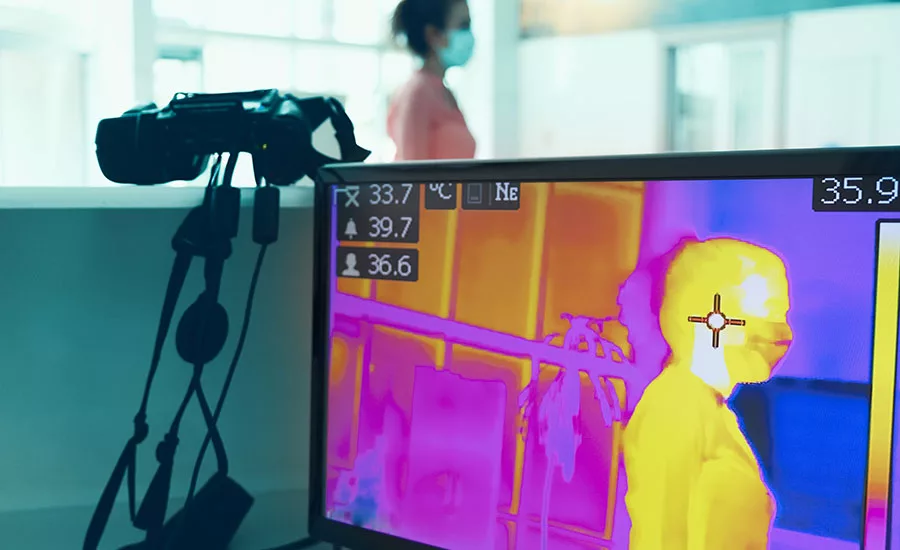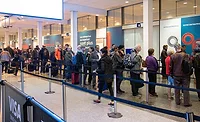Top 5 myths about temperature checks

As the United States continues to struggle amid the COVID-19 pandemic, many companies have been searching for creative solutions to help stop the spread of this virus. One of these solutions includes thermal temperature screening checker systems which scan individuals entering a store or school, and quickly identify whether they have an elevated temperature. A wise man once said “The single biggest threat to man’s continued dominance on this planet is the virus,” Nobel Prize-winning biologist Joshua Lederberg.
While these thermal camera systems have been implemented in many places of business, hospitals, airports and schools across the country, there seems to be considerable misconceptions about the camera technology and its effectiveness.
Here are some of the most common misconceptions I’ve come across about temperature checking systems.
Myth 1: It Doesn't Work - What about false positives and asymptomatic cases?
A common concern of thermal cameras and other temperature check systems is that they only detect skin temperature and a person’s skin temperature may be raised due to external factors, such as the weather. This may lead to people who do not actually have a fever to trigger the system into a false positive.
While this is a possibility, using thermal cameras as a preliminary temperature check and following this up with a secondary check with a medical thermometer for only those who trigger the system is a good way to eliminate these false positives. Thermal systems also allow for many more people to be scanned in a short amount of time, reducing crowds and lines.
Another concern is that about 25% of COVID-positive people are asymptomatic, meaning they would not have a fever, therefore not triggering the Temperature checking system.
Checking a person’s temperature has been effectively used for centuries as a way of detecting disease and while not every person with COVID-19 will be symptomatic, for those that are, a fever is one of the most common symptoms of the virus, according to the CDC.
A study in the International Journal of Infectious Disease also shows that viral loads are lower in asymptomatic patients, meaning the likelihood of an asymptomatic person spreading the virus is lower than someone that would be flagged in a temperature check.
While asymptomatic people may be less contagious than symptomatic people, they do still run the risk of spreading the virus, but just like masks, temperature checking isn’t a foolproof method of stopping the spread of COVID-19; however, it can be an important tool to help decrease infection.
Myth 2: Thermal cameras are not as accurate as handheld thermometers
Another concern about thermal cameras used for temperature checking is that they are not accurate or not as accurate as a medical thermometer when taking temperatures and therefore are not effective in identifying an individual with a fever.
Each temperature checking system is different so it is best to have a system that has been verified by an outside study. A recent study published in the Cambridge University Press found that Athena temperature checking thermal camera systems were able to identify a person with an elevated skin temperature in eight out of eight trials and were accurate within .3 degrees Celsius of a medical thermometer that is 100%.
The FDA has also released guidelines for the use of thermal cameras, which recommend the use of a Heat Source Reference Point (HSRP) or “blackbody” to ensure an accurate read of temperature.
Systems that use an HSRP will be able to accurately measure temperature throughout the day, whereas those that don’t will need to be recalibrated multiple times throughout the day otherwise they will not be able to adjust to changing room temperatures.
Myth 3: All temperature detection systems are the same
As mentioned in the previous section, not all temperature checking thermal camera systems are connected to an HSRP, meaning that if the temperature of the room rises or lowers, the system will be thrown off and will need to be recalibrated to get an accurate read.
Using an HSRP allows the thermal camera system to adjust to changing room temperature and still get an accurate body temperature scan from individuals else if you don’t have me you must adjust the system manual each time the room temperature changes like someone opens a door.
It’s important to acknowledge that there are systems on the market that do not use an HSRP or comply with FDA guidelines. Some systems claim to scan multiple people at once, however, this has not been proven to be effective and have shown multiple technical issues, such as not having enough points of temperature reading, or bad angles when measuring multiple people, or inaccurate readings as the further you are away from the reference point the more inaccurate any system will become.
While there are systems like these that are inaccurate and cheap, it’s important to distinguish between these and systems that do use an HSRP, have been tested, and comply with or exceed FDA guidelines.
Myth 4: I can get any camera and protect my customers
As we mentioned earlier, not all thermal camera systems are equal and some are not NDAA compliant and are even blacklisted by the United States government.
Some companies have been blacklisted because of potential Chinese spyware that can send your camera images to places not when you are not aware of it yet they are still being sold by USA under other names and used in schools, airports and maybe even your place of work. These companies are selling cameras at a cheaper price, but are putting students and staff at risk of potential privacy invasion. Other companies, for instance, use all NDAA chips but don’t allow camera’s to touch the network as they plug directly into the Apple iPad to evade any kind of hacks to the system.
Temperature checking thermal cameras can be an important tool in minimizing the spread of COVID-19, allowing the public to return to a somewhat normal life; however, rushing to instill cameras that are not NDAA compliant or do not comply with the FDA will only put more people at risk.
Myth 5: Thermal cameras give a false sense of security
Finally, another common concern is that businesses rushing to reopen will feel a false sense of security by using thermal cameras because they do not prevent the spread of COVID-19 100 percent.
This is an argument that was also made about masks at the beginning of the pandemic because masks are not 100 percent effective in stopping droplet spread of COVID-19.
Just because thermal cameras or masks are not 100% effective does not mean they should be written off or not used. If a thermal camera stops 80% of COVID-positive people from entering an establishment or event, that 80% is better than 0%.
Of course, it’s important to make sure the thermal camera system for temperature checking you’re using is accurate, tested by a 3rd party, using an HSRP, meeting FDA guidelines and is NDAA compliant - there are systems on the market that cut these corners and do give a false sense of security to their customers.
Ultimately, using good thermal camera systems that have been researched and certified in addition to secondary temperature checks and other COVID-safety measures as recommended by the CDC can help reduce the spread of this disease, and other diseases, saving lives.
This article originally ran in Security, a twice-monthly security-focused eNewsletter for security end users, brought to you by Security Magazine. Subscribe here.
Looking for a reprint of this article?
From high-res PDFs to custom plaques, order your copy today!







